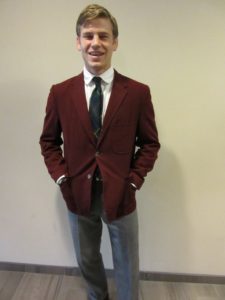Fashion as a form of expression oftentimes is synonymous with a certain clientele of individuals — namely, young millennials exercising an experimental and creative wing. Yet using clothing as a means of communication has never been limited to one age group — and it’s time that is celebrated.
College campuses evoke an environment where experimental fashion choices are an expected — and even stereotypical — array of imagery, yet such deliberate choices must be limited to the students who live and learn there. For the faculty that help make an academic environment what it is, fashion can also be utilized effectively.
For political science professor Suzanne Chod, distinguishing what is appropriate for the classroom versus weekend or off-campus activities is important to help communicate a strong, clear message.

Dr. Suzanne Chod, associate professor of Political Science (Photo by Samantha Loveland)
“As a woman in a position of authority, I think it is…important to present myself in a way that shows I take that position seriously and, therefore, students should take me seriously,” Chod said.
Truly, just as in any professional environment what is worn by an individual often carries a message concerning the personality, level of authority, or preferences of that individual. Whether that message is conscious or not — as well as how it is ultimately interpreted — is indeed often variable, nonetheless.
“A supervisor once told me to dress for the position you aspire to be in,” communications professor Emily Cramer said. “I always tell my students who are preparing to go on job interviews to…infuse texture and personality into their wardrobe. It displays an elevated level of confidence.”
Setting oneself apart in the professional word is important, Cramer says, to exert some creativity and individuality. Clothing can help exude this.
“Dress in a way that projects where you want to go professionally,” Cramer said.
Yet choices of dress are often signs of the individual levels of comfort that a person surrounds themselves in when around others. Certain staples often make it into a person’s wardrobe that come to define both their tastes and even their own expectations for themselves.
“Classic pieces like black pants, trench coats, button down shirts, etc. have always been in my wardrobe,” Chod said. “I…lack the ‘creative gene.’ I don’t sing, dance, paint…But, I can be creative with fashion. I enjoy putting outfits together and feel excited when what I pictured in my head works out well.”
Indeed, as an outlet for creativity, many look to fashion as a means to exercise such an itching. For area hall director Andrew Zobac, inspiration can be found both on the silver screen and in what many would call the golden age.
“I typically enjoy a ’50s or ’60s American collegiate style. Think ‘The Graduate,’ ‘Dead Poet’s Society,’ or ‘North by Northwest.’ Classic clothes seem to improve with wear,” Zobac said.
Finding one’s creative muse in such cinematic cultural sources is not a foreign concept, given the social importance of such films. Zobac’s incorporation of such influences details just one example of the source for fashion varying extensively among individuals who harbor different tastes.
Such choices also reflect an individual’s personal background — like many aspects of one’s life, such features are influenced by one’s history.
“My ability to afford pieces I used to covet has changed. Money was an issue growing up. A goal I set for myself as a young woman was to someday be able to afford to follow my fashion interests. In some ways, expressing myself through fashion as a professional woman is a symbol I met that goal,” Chod said.
Chod’s experience with using fashion as a way to personify her professional triumphs illustrates the ways in which clothing can signify more than an unconscious, superficial choice.

Area hall director Andrew Zobac (Photo by Samantha Loveland)
Zobac similarly expressed his partiality towards clothing that serves a greater purpose — that of functionality.
“While a college athlete…athletic clothes made sense. They were functional. Now when I’m walking out the door, instead of a warm-up jacket and running shoes I slip on a sport coat and loafers. They are functional,” Zobac said.
Ultimately, the choices made in regards to fashion wear are just that —choices. They are deliberate and can reflect both the histories and the futures of the individuals that choose them. North Central faculty are no exception to utilizing such a method of expression to send a message, and can be looked to as inspiration in the academic world — and in the fashion world as well.

